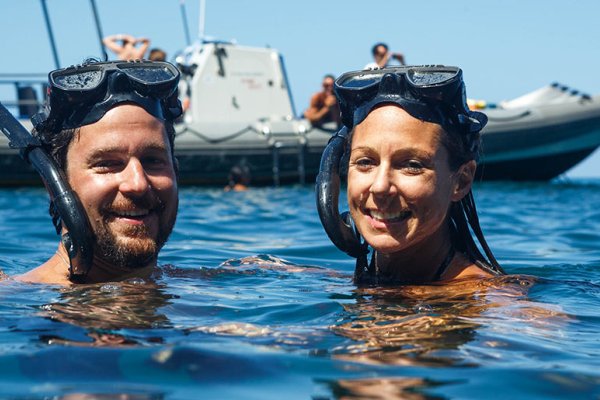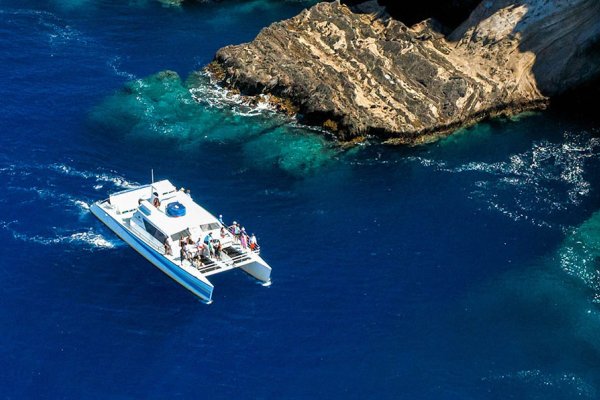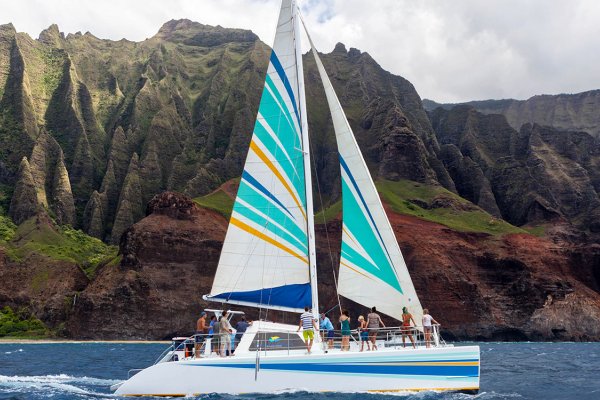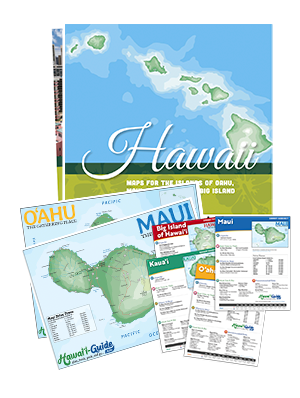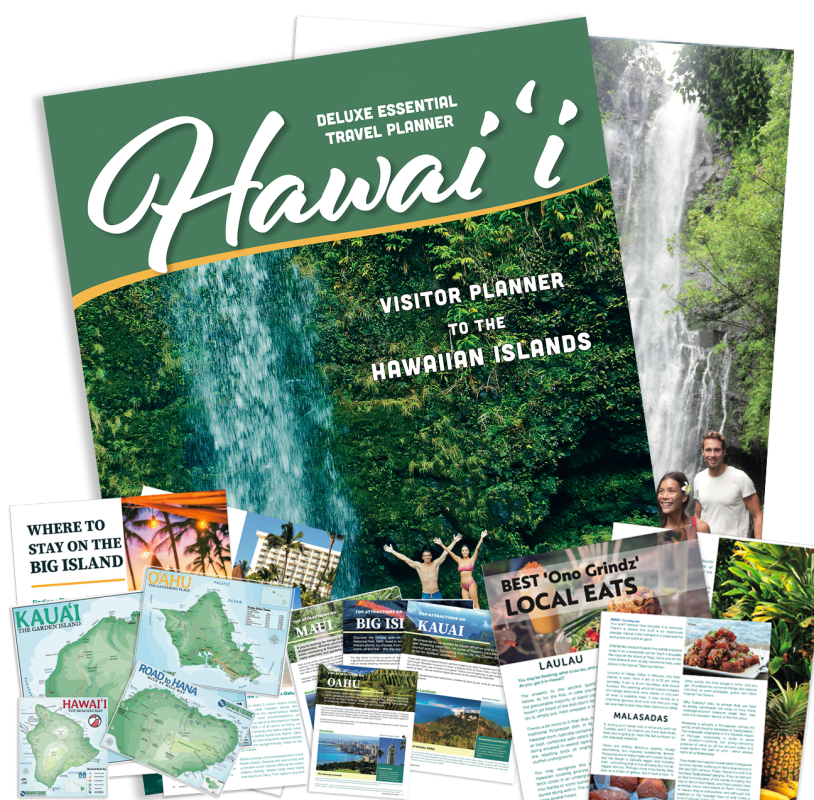Best Snorkeling Beaches on Kauai
Snorkeling Adventures
Best Beaches to Snorkel in Kauai
Kauai is the perfect place to snorkel. Roughly 50 of the 90 miles of coastline is white sand beach, which makes for easy ocean access. Top that off with lots of family-friendly spots, as well as places for those with more experience, and Kauai is every snorkeler's dream.
And because we want you to find your perfect slice of snorkeling heaven, we're presenting our picks for Kauai's best snorkeling beaches here. We've split them up into those that are ideal for beginners, and those better left to intermediate or advanced snorkelers.
— article continued below —
2024 Kauai
Visitor Guides
Visiting Kauai soon?
Grab Your Copy!
~ Detailed maps, insider tips, and more starting at only $6.95! ~
Kauai Snorkeling Safety
Please take safety into consideration before snorkeling, especially if venturing out of protected areas where stronger currents can overpower a swimmer. A general rule of thumb to follow before getting in the ocean is to find a comfortable place in the shade and observe the water for 20 minutes before entering. It is important to observe the current and identify any obstacles such as rocks. Being aware of your surroundings will help keep your snorkeling adventure as safe as it is fun.
Also, please be mindful of the coral reef, as it is a very delicate living organism. Make sure not to step or walk on the reef, and do not touch the coral or any of its inhabitants; for the reef's health, as well as for your own safety. You'll also want to take a reef safe sunscreen, as traditional sunscreens damage the reefs.
Snorkeling For Beginners
Lydgate Park, Keiki Pond
The keiki (children's) pond at Lydgate Park is a great place to try snorkeling for the first time. This water is protected year round from the surf by a man-made rock wall, the pond gets as deep as 10' in places, and there are numerous fish swimming near the outer rocks. There is no coral here and the beach is popular with families. It is a great place to put on the mask, fins, and snorkel for the first time without having to worry about ocean currents or crashing waves.
Poipu Beach Park
If you are on the South Side there is no need to travel far to snorkel for the first time. As long as there is not a large south swell, Poipu Beach Park is a good beginner spot. The snorkeling area at Poipu Beach is small, as most of the area has a sand bottom. However, just to the right of the sand is a rocky area with a little coral, some fish, and usually several people! If you are lucky, you'll spot a Hawaiian monk seal lying on the beach.
Intermediate and Advanced Snorkeling
Nualolo Kai
The reef at Nualolo Kai is one of the best snorkeling locations to visit on Kauai. You can expect to see lots of fish and very healthy coral. In the morning, before the wind picks up, the visibility at Nualolo Kai is at its best. Nualolo Kai is on the Na Pali Coast and is only accessible by boat and when conditions allow; generally between the months of April and September. Not all tour boats stop at Nualolo Kai, so be sure you book with a company who does.
Kee Beach
Kee Beach, at the end of the road on the North Shore, can be excellent for snorkeling when the surf conditions permit. It is most easily accessible during the summer months. Be aware of the strong rip current that can exist on the left side of the reef where it opens up to the ocean. Kee has a barrier reef with plenty of marine life- it's a comfortable intermediate snorkeling location. Please be mindful to not step on the reef here.
The area outside the reef at Kee is for experts only, but the marine life is abundant. As a result, it's common to see locals spear fishing in this area. Do not go outside the reef unless you are very experienced swimming in the ocean and have a clear plan for how to get back in. The rip current may help you get out through a shallow crack in the reef; however, it is often not easy to get back because the current is pushing against you. There have been sightings of turtles, Hawaiian monk seals, and even an occasional white-tipped reef shark here.
Tunnels (Makua) Beach
Tunnels is a deceptively large horseshoe-shaped snorkeling area. The outer reef, which has excellent coral formations and lots of marine life, is for advanced snorkelers only, as it is exposed to strong ocean currents. The best entry point is the water near the point (far right side of the reef when looking out from shore). You can then swim out to the inside portion of the outer reef. Be aware that the current will be pushing you back towards Haena Beach Park. Follow the curve along the outer reef; there are varying depths here from 3'-40'. When you get in the shallows, the current can be very strong. As you approach the far left side of the reef (when looking from shore), head directly to shore and back to the beach (you will be crossing a channel). Under no circumstances should you follow the reef out and away from shore – the exit current can be very strong around the left corner of the reef.
For beginners, there is a protected shallow area with small caves (or tunnels) on the inner reef which is usually a safe place to get in the water when the surf isn't big. It is on the left side of the beach closest to Haena Beach Park (where you come back in from the outer reef advanced snorkel).
Like the rest of the North Shore of Kauai, large north swell is common in the winter. In such conditions, even strong swimmers will not be able to snorkel at Tunnels. During that time of year, we suggest you head to Koloa Landing or Lawai Beach on the South Side.
Tunnels Beach has very limited parking because it is a popular snorkeling area. If it is overcrowded, there is more parking at Haena Beach Park. It is a beautiful (albeit long) walk from there to the tunnels.
Hideaways Beach
In order to access this beach, you have to follow a steep trail from just in front of the St Regis Resort. Hideaways' turquoise blue water is perfect for snorkeling when the conditions are good. The reef here is shallow with lots of pockets or deep grooves to explore and an abundance of fish. It's not necessary to swim very far out over the shallow reef; the snorkeling isn't any better, and you will be exposing yourself to more hazardous ocean conditions. During high swell, visibility is impaired and it may not be safe to enter the water.
Koloa Landing
If you are on the south side, Koloa Landing is best for snorkelers who are excellent swimmers with more advanced skills. This is a popular diving location, but there is a fairly long swim across a sandy area. There is limited sea life in this area, but you will see plenty when you get to where the snorkeling is good (either side of the bay). Koloa landing is also exposed to the open ocean, so don’t go here when there is a large south swell (usually during the summer).
There is no beach at Koloa landing; you enter the water from a boat ramp. If there has recently been heavy rain, do not snorkel at Koloa landing. There is a small stream near the boat ramp- do not snorkel near it as the stream clouds visibility and may carry run off from the livestock farming operations that are upstream.
Lawai Beach
Lawai Beach is a reliable snorkeling area protected by a barrier reef that hosts abundant numbers of fish. If you want to try out snorkeling, we highly recommend taking a snorkel tour. After you have gone with a guide, you'll have learned the basics and will be more comfortable snorkeling independently. Note that visibility gets better (and the coral much healthier) the farther out towards the reef you go, but don’t venture outside the reef.
Lawai Beach can be crowded because it is one of the best snorkeling spots on Kauai. It is particularly important to be aware of the currents at Lawai Beach in high wind or south swell. It is also very easy to access with ample street side parking available. There is a small sand beach on the left side of the bay that disappears at high tide, and the lawn in front of the beach house restaurant which borders the east side of the bay is also a nice place to relax.
If you are a confident swimmer and have been snorkeling a couple of times before, Lawai Beach is an excellent choice.
No matter where you choose to snorkel on Kauai, be safe; be respectful of the marine life whose home you are visiting; and, of course, have fun!


